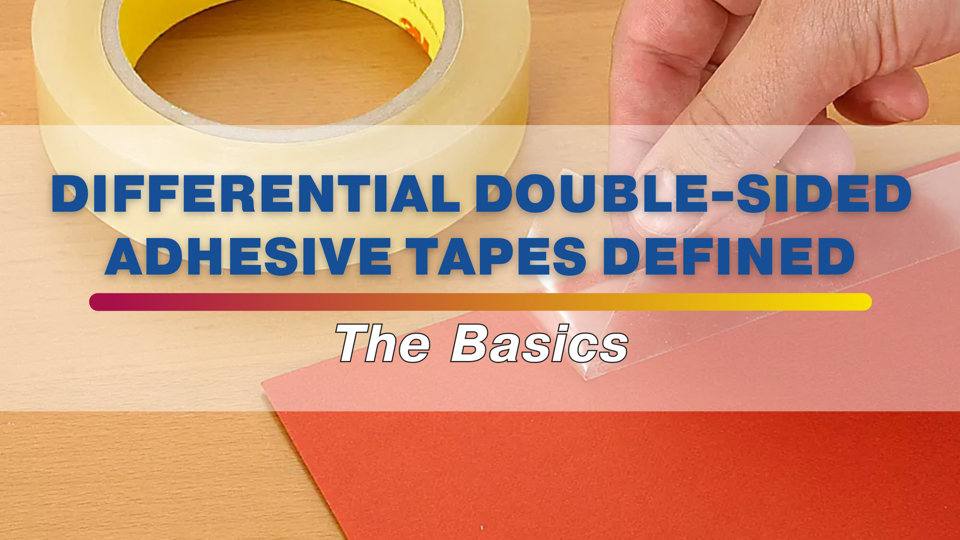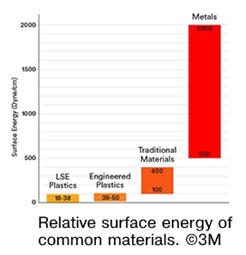Differential Double-Sided Tape Defined | The Basics

Differential Pressure-Sensitive Adhesive Tape
This post — the first in a three-part series — is about...you guessed it...differential double-sided pressure-sensitive adhesive tape. Here we’ll cover the basics of differential double-sided tape and set the stage for more focused discussions of the automotive (Part II) and medical (Part III) applications of differentials.
You’re here because you want to (1) know more about differential double-sided Pressure-Sensitive Adhesive (PSA) tape, (2) learn what makes differential PSA tapes so unique, and (3) find out why you would want to use a differential double-sided tape.
We know you’re in a hurry. So, let’s cut to the chase.
- A differential pressure-sensitive adhesive tape is a special double-sided tape with different adhesives on either side of the carrier.
- In addition to stock or standard double-sided differential tapes, many suppliers can also create custom formulations
- You might opt for a differential pressure-sensitive adhesive tape when:
- You need to bond two materials with significantly different physical properties, i.e., dissimilar materials (surface energy, texture, thermal expansion rates, chemical compatibility, etc.)
- Repositioning and removability are essential in your bonding or joining application
If you’ve got what you need and are ready to start your custom die-cut parts project, we’d love to hear from you.
But, if you’d like to stick around a bit longer to learn more about differential double-sided pressure-sensitive adhesive tape and what makes this special PSA tape so darn special, please read on.
Bonding & Joining with Pressure-Sensitive Adhesive Tapes
Bonding, joining, and splicing materials are critical in manufacturing and assembly. Die-cut pressure-sensitive adhesive tapes are a popular option for these tasks because they're easy to use and available in many varieties.
Adhesive tapes are so popular, in fact, that a recent survey by Markets & Reports projects the global pressure-sensitive adhesive tape market will reach $61 billion by 2026.
Unfortunately, when we want to use an adhesive tape to join two entirely dissimilar materials, it may quickly become apparent that not all double-sided pressure-sensitive adhesive tapes are created equal.
What’s a Differential Pressure-Sensitive Adhesive Tape?
 Differential double-sided or double-coated adhesive tapes are a specific type of double-coated adhesive tape.
Differential double-sided or double-coated adhesive tapes are a specific type of double-coated adhesive tape.
What makes differential double-coated tapes so special is the unique adhesive they have on each side of their carrier material. It's this two-sided, differential feature that makes it possible for you to bond objects together that are made from materials with very different physical properties.
Note: For a double-sided adhesive tape to be called a differential tape, the adhesives on each side of the tape carrier must be different in some way.
What Makes the Adhesives on a Differential Double-Sided Tape Different?
The adhesives on either side of a differential pressure-sensitive adhesive tape’s carrier may be different in two main ways:
- Adhesive thickness – One side of the tape may have a thicker pressure-sensitive adhesive layer.
- Adhesive type – One side of the tape may have a modified acrylic adhesive and the other a rubber-based adhesive.
Why Would I Want a Differential Double-Sided Pressure-Sensitive Adhesive Tape?
There are two main reasons that might have you choose to use a differential double-sided pressure-sensitive adhesive tape rather than a traditional double-sided tape: Repositionablity / Removeability and Dissimilar Materials.
Repositionablity / Removeability
Repositioning and removing are both reasonably self-explanatory. A differential double-sided adhesive tape may have a permanent PSA on one side and a less aggressive, removable adhesive on the other. A tape with these two types of PSA will:
- Allow you to remove it from the substrate after you’ve attached it (like promotional displays you want to remove after the promotion), or
- let you unstick and re-stick it if you put it in the wrong place or want to move it later.
Examples are changeable foam gaskets, resealable bags, and peel-and-stick polishing pads.
Dissimilar Materials
Dissimilar materials, or materials that in some way are very unique or obviously different, pose their own set of challenges that can often make it very difficult for us to use adhesive tape to bond and join them.
In this case, it might be necessary to use nuts, bolts, or screws (aka mechanical fasteners) that can be weighty and damage the materials. Fortunately, there's usually a differential pressure-sensitive adhesive tape to get the job done.
But what exactly are dissimilar materials?
And what makes them so different from each other in the first place?
Defining Dissimilar Materials for Double-Sided Differentials
To keep it simple, when we refer to “dissimilar” materials, we’re typically talking about materials that are significantly different from each other.
For starters, dissimilar materials could be made of entirely different substances. Glass and polypropylene, for example.
Dissimilar materials could also have surface finishes that are significantly different from one another, or even opposing surface energy levels.
Here's a summary of the main reasons why dissimilar materials can have bonding requirements that'll have you reaching for differential double-sided pressure-sensitive adhesive tape:
- Different surface energies: Every material has a surface energy. Surface energy measures how much a material wants to bond with other materials. Check out Bonding Low Surface Energy (LSE) Materials for more info.
- Chemical incompatibility: Some materials may not bond well with an adhesive tape because of
 chemical reactions between the adhesive used in the tape and the material's surface. For example, plasticizers can leach out of PVC and cause some pressure-sensitive adhesive tapes to fail.
chemical reactions between the adhesive used in the tape and the material's surface. For example, plasticizers can leach out of PVC and cause some pressure-sensitive adhesive tapes to fail. - Differing thermal expansion rates: As materials heat up or cool down they expand and contract at different rates. Over time, this repeated change in size can make it difficult for a tape to maintain a strong bond.
- Surface Characteristics: Dissimilar materials can have different surface characteristics — roughness, bumps, voids, or gaps — all making it tough for certain adhesives to latch onto, reducing the final bond strength of the tape.
Suppose you’re bonding two materials with tape, and they have one or more of the characteristics we discussed above. In that case, you could benefit from a differential double-sided adhesive tape designed specifically to compensate for just those differences.
Differential Double-Sided Adhesive Tape & Dissimilar Materials: One Tape to Bond Them All
As you read above, different materials can have very different adhesive requirements. For many reasons, joining these materials may challenge traditional double-sided pressure-sensitive adhesive tape.
Here are a few examples of dissimilar materials you might want to bond with tape — and why a differential double-sided pressure-sensitive adhesive tape can help:
|
Material A |
Material B |
Why Differential Double-Sided Adhesive Tape? |
|
ABS Plastic |
Aluminum |
Thermal Expansion: ABS has a higher coefficient of thermal expansion than aluminum. |
|
Rubber |
Steel |
Surface Energy: Rubber has low surface energy, while steel has high surface energy. |
|
Foam |
Wood |
Substrate Topography: Uneven surfaces may require different adhesive types. |
|
PTFE |
Steel |
Chemical Incompatibility: PTFE has very low surface energy and is chemically inert. |
Differential Double-Sided PSA Tapes: More than Just Double-Sided Tape
As you’ve seen, differential pressure-sensitive adhesive tapes are not just your average double-sided tape. These specialized tapes feature different adhesives on each side, allowing them to adhere to many different materials with varying levels of adhesion strength and unique surface characteristics.
The design of differential double-sided tapes makes them ideal for a wide range of applications, including bonding two very different materials together – like plastic and glass or wood and steel –mounting emblems onto vehicle exteriors and temporarily securing display items in place.
With differential double-sided adhesive tapes, you can achieve a secure and reliable bond, no matter the materials, that can be designed to withstand various environmental conditions and can be easy to remove without damaging surfaces or leaving behind any residue.
Key Takeaways
|
JBC Technologies for Pressure-Sensitive Adhesive Tape Selection & Custom Die-Cut Parts
We’re a trusted partner to our many pressure-sensitive adhesive tape manufacturers. As a result, we have gained preferred converter status with three of the greats — 3M™ Preferred Converter and 3M™ Medical Materials & Technologies Preferred Converter, Avery Dennison ADvantage Converter, and Berry Global Elite Converter.
When you partner with JBC Technologies for your custom die-cut adhesive tape project, we’ll work closely with you and our adhesive tape manufacturer partners to determine the best tapes for the job. We’ll also optimize the die-cutting processes and automated assembly systems needed to enable us to integrate our adhesive tapes onto your custom die-cut solutions.
Contact us today to get started on your next custom die-cutting project.